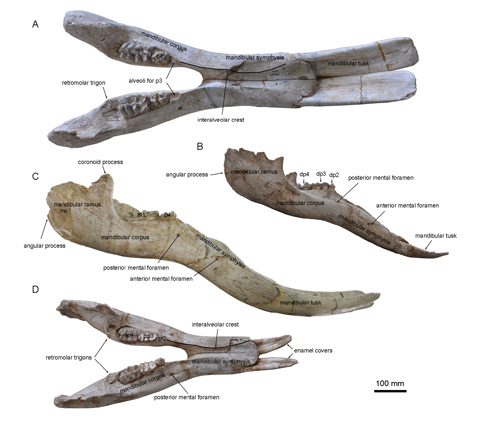Konobelodon is a lesser known proboscidean species and was firstly reported in USA in 1990. Owing to very few data, the researchers have not known much about its morphology, and its classification status has been controversial. In 2015, the occurrence of Konobelodon was confirmed in the Old World after a research team from Greece classified Mastodon grandincisivus and Tetralophodon atticus from Europe and Western Asia into Konobelodon.
In the Late Miocene strata, Linxia Basin, Gansu, China, a lot of fossil proboscideans were found. The previous studies simply identified these materials as Tetralophodon exoletus, but the study results in Greece gave the researchers an important hint. After in-depth comparative study, Tetralophodon exoletus found in Linxia Basin is also classified into Konobelodon in fact. The researchers established a new species, Konobelodon robustus. The latest research result was published in Geodiversitas, 2016, Volume 38, Issue 1.
The study result shows that the Konobelodon robustus in the Linxia Basin, Gansu is much earlier than that in Europe and America in the age, and it has many primitive features, so it is the ancestor of the other two species. The study also questioned the previous study verdict that the Konobelodon is originated from the Platybelodon as the Konobelodon robustus has a tiny dentine column structure in the lower incisors, which represents the initial evolutionary stage of dentine column. The dentine column structure in the lower incisors in the Platybelodon has been developed well. Therefore, the similar structure in both Konobelodon robustus and Platybelodon supposed to be originated separately and cannot represent the same lineage. Meanwhile, the research also gave two possibilities or the origin of Konobelodon robustus, one is that Konobelodon robustus and American Amebelodon are in a relation of sister group, and both are originated from Protanancus in Eurasia; the other is that the Konobelodon robustus originates from Tetralophodon in Eurasia.
This research is funded by the National Key Basic Research Development Program, CAS Strategic Priority Research Program, and the National Natural Science Foundation of China.

Konobelodon robustus ,(Provided by Wang ShiQi)